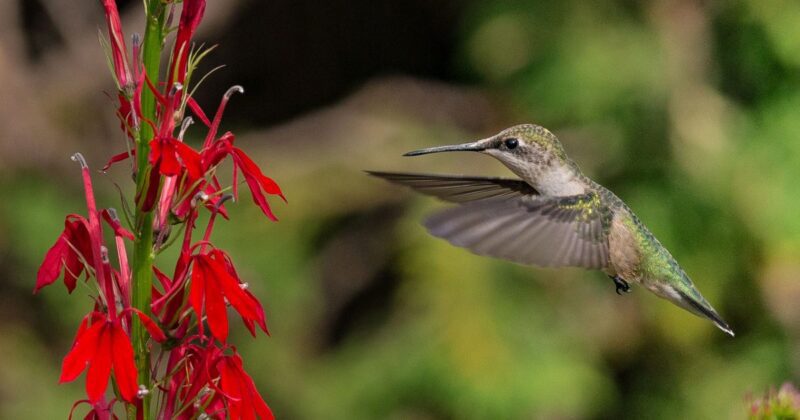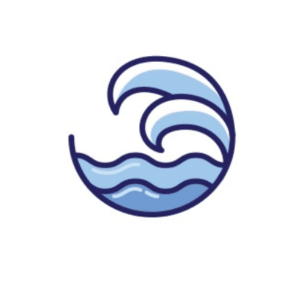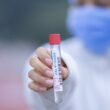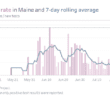If you seek joy, invite a pair of hummingbirds into your life.
Ruby-throated hummingbirds share our home ground, making surprise appearances throughout the summer. Turn on the garden hose and one may materialize out of nowhere – eager to dart in and out of the water droplets.
They drink sap from a willow tree and nectar from blossoms such as the dangling white bell flowers of Solomon’s seal.
Watching them, I am reminded that plants are the ultimate bird feeders. There’s no need for red plastic feeders filled with sugar water.
Every year I add more native plants to provide food sources throughout the growing season for the hummingbirds and other pollinators. This summer fresh inspiration came from entomologist Doug Tallamy’s latest book, “Nature’s Best Hope: A New Approach to Conservation That Starts in Your Yard.” With the pandemic confining us to home terrain, it’s an ideal time to consider inviting more wildlife into our lives.
A ‘Homegrown National Park’
Tallamy, a professor of insect ecology at the University of Delaware, calls for a shift from humans’ long-standing “adversarial relationship” to the natural world, warning that “we are winning our undeclared war against insects at our own peril.” Since 1974, invertebrate abundance globally has fallen 45 percent.
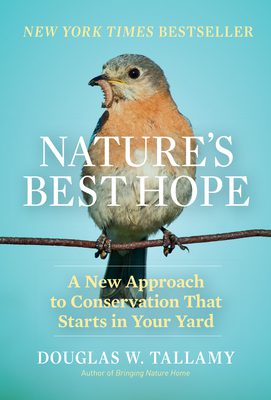 Ninety-six percent of bird species depend on insects to feed their young. Due in part to lost habitat and food sources, bird populations have plummeted over the last 50 years. To help reverse those declines, Tallamy advocates for landscaping that incorporates a diverse mix of native trees, shrubs, wildflowers and groundcovers that can better sustain local food webs.
Ninety-six percent of bird species depend on insects to feed their young. Due in part to lost habitat and food sources, bird populations have plummeted over the last 50 years. To help reverse those declines, Tallamy advocates for landscaping that incorporates a diverse mix of native trees, shrubs, wildflowers and groundcovers that can better sustain local food webs.
Tallamy first urged readers to “garden as if life depended on it” 13 years ago in “Bringing Nature Home.” His new book, based on more recent research, shows just how reliant birds and insects are on native plant species.
Restoring ecological health can’t be done simply through “patches of protected areas,” Tallamy writes, when 86 percent of the land in the eastern U.S. is privately owned. If private landowners dedicated even half their land to native plant habitat, the U.S. could create what he calls a “Homegrown National Park,” a network of wildlife habitat spanning up to 20 million acres.
The collective impact of that ecological yardscaping could be huge, Tallamy argues, even when individual lot sizes are small. He cites the example of a Chicago homeowner, living near O’Hare International Airport and an expressway, whose native plant oasis in a tenth-of-an-acre backyard has attracted more than 100 bird species.
Plants as bird feeders
The United States has an area the size of New England in turfgrass, a non-native monoculture that sucks up 30 percent of summer water use in the East (and more in the West). Lawns are often treated with chemicals (some of them cancer-causing) and with fertilizers that contaminate waterways.
Turfgrass is also poor at filtering water and sequestering atmospheric carbon. Compared to meadows, shrubs or trees, Tallamy notes, “lawns are terrible at delivering the essential ecosystem services we all depend on.”
When Tallamy and his students surveyed 22 housing developments in the mid-Atlantic, turfgrass dominated 92 percent of the landscaped area – leaving few food sources or nesting sites for wildlife. A study of suburban chickadees in that region found that to breed successfully, the birds needed yards to have at least 70 percent native species (measured by plant biomass).
In place of lawn, Tallamy suggests planting an assortment of native “keystone species,” which he defines as those having a “disproportionately large effect on the abundance and diversity of other species in an ecosystem.” In our region, a small percentage of tree genera – primarily oaks, cherries and willows – host 70 percent or more of moths and butterflies.
These Lepidoptera, in their caterpillar stages, provide critical food for young birds, which can’t yet consume bird seed, suet or tougher insects. To reach adulthood, hatchlings depend on soft caterpillars – hundreds a day for a typical hatch.
Too often, Tallamy notes, we see “our” plants as a zero-sum game; either we can enjoy our plants or the caterpillars can. But even with a food crop like blueberries, it’s possible for caterpillars to eat some of the leaves and bees to harvest flower nectar while leaving humans most of the fruits.
Home as habitat
For Tallamy’s vision of a “Homegrown National Park” to take hold, we need to consider not just what we plant but how we maintain our properties. He describes the need to minimize outdoor lighting (using motion sensors and full cutoff fixtures that direct light downward) and to postpone “fall cleanup” – raking leaves, mowing meadows and cutting back perennials – until early spring, given that dried grasses and leaf litter provide essential winter habitat for pollinators and other insects. Homeowners also need to eliminate use of pesticides, which kill countless beneficial insects alongside the targeted ones.
Tallamy’s book focuses on changes needed at the landowner level, but the nursery trade must also adopt a more ecological focus. Native plant selections remain limited, making it hard for landowners to implement the ambitious vision Tallamy outlines.
A self-described “optimist of necessity,” Tallamy is confident that “landscaping will become synonymous with ecological restoration.” Taking action, even on a small scale, can help foster a sense of efficacy in the face of daunting global challenges.
Nurturing home-scale habitats is not a “sacrifice” made solely to benefit future generations. The rewards are evident here and now, Tallamy observes – in improved pollination and natural pest control, increased carbon storage, reduced runoff pollution, and a seasonal parade of bees, birds and butterflies.
Some of the biggest benefits take the smallest of forms. On our land, we will plant what it takes to keep the hummingbirds happy.
Resources
- Native Plant Trust Garden Plant Finder
- Native Plant Finder (on the National Wildlife Federation site)
- Audubon’s Plants for Birds search tool
- Go Botany database of northern New England native plants
- Wild Seed Project Plant Lists (Disclosure: Schauffler is an editor of Wild Seed magazine, a publication of the Wild Seed Project)
- Arni Stinnissen photography

